
Kobellite is a gray, fibrous, metallic mineral with the chemical formula Pb22Cu4(Bi,Sb)30S69. It is also a sulfide mineral consisting of antimony, bismuth, and lead. It is a member of the izoklakeite – berryite series with silver and iron substituting in the copper site and a varying ratio of bismuth, antimony, and lead. It crystallizes with monoclinic pyramidal crystals. The mineral can be found in ores and deposits of Hvena, Sweden; Ouray, Colorado; and Wake County, North Carolina, US. The mineral was named after Wolfgang Franz von Kobell (1803–1882), a German mineralogist.

Arsenopyrite is an iron arsenic sulfide (FeAsS). It is a hard metallic, opaque, steel grey to silver white mineral with a relatively high specific gravity of 6.1.

Stibnite, sometimes called antimonite, is a sulfide mineral with the formula Sb2S3. This soft grey material crystallizes in an orthorhombic space group. It is the most important source for the metalloid antimony. The name is derived from the Greek στίβι stibi through the Latin stibium as the former name for the mineral and the element antimony.
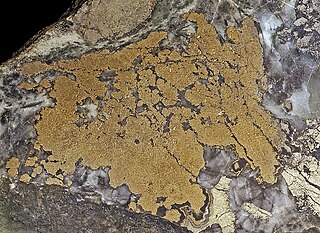
Nickeline or niccolite is a mineral consisting primarily of nickel arsenide (NiAs). The naturally-occurring mineral contains roughly 43.9% nickel and 56.1% arsenic by mass, but composition of the mineral may vary slightly.

Realgar, also known as ″arsenic blende″, ″ruby sulphur″ or ″ruby of arsenic″, is an arsenic sulfide mineral with the chemical formula α-As4S4. It is a soft, sectile mineral occurring in monoclinic crystals, or in granular, compact, or powdery form, often in association with the related mineral, orpiment. It is orange-red in color, melts at 320 °C, and burns with a bluish flame releasing fumes of arsenic and sulfur. Realgar is soft with a Mohs hardness of 1.5 to 2 and has a specific gravity of 3.5. Its streak is orange colored. It is trimorphous with pararealgar and bonazziite.

Ullmannite or Nickel glance is a nickel antimony sulfide mineral with formula: NiSbS. Considerable substitution occurs with cobalt and iron in the nickel site along with bismuth and arsenic in the antimony site. A solid solution series exists with the high cobalt willyamite.

Freieslebenite is a sulfosalt mineral composed of antimony, lead, and silver. Sulfosalt minerals are complex sulfide minerals with the formula: AmBnSp. The formula of freieslebenite is AgPbSbS3.

Lorándite is a thallium arsenic sulfosalt with the chemical formula: TlAsS2. Though rare, it is the most common thallium-bearing mineral. Lorandite occurs in low-temperature hydrothermal associations and in gold and mercury ore deposits. Associated minerals include stibnite, realgar, orpiment, cinnabar, vrbaite, greigite, marcasite, pyrite, tetrahedrite, antimonian sphalerite, arsenic and barite.
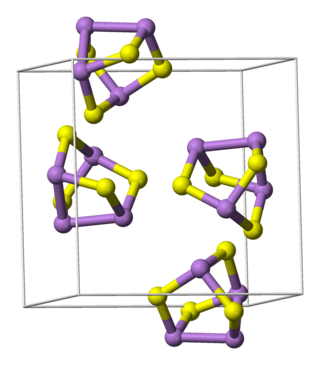
Pararealgar is an arsenic sulfide mineral with the chemical formula As4S4, also represented as AsS. It forms gradually from realgar under exposure to light. Its name derives from the fact that its elemental composition is identical to realgar, As4S4. It is soft with a Mohs hardness of 1 - 1.5, is yellow orange in colour, and its monoclinic prismatic crystals are very brittle, easily crumbling to powder.

In crystallography, the hexagonal crystal family is one of the 6 crystal families, which includes two crystal systems and two lattice systems. While commonly confused, the trigonal crystal system and the rhombohedral lattice system are not equivalent. In particular, there are crystals that have trigonal symmetry but belong to the hexagonal lattice.
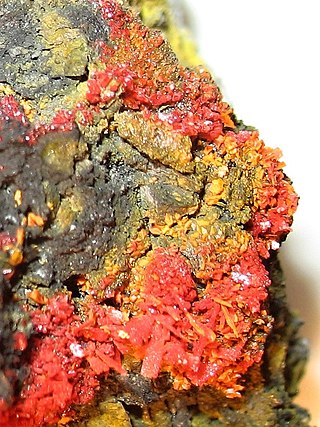
Alacránite (As8S9) is an arsenic sulfide mineral first discovered in the Uzon caldera, Kamchatka, Russia. It was named for its occurrence in the Alacrán silver/arsenic/antimony mine. Pampa Larga, Chile. It is generally more rare than realgar and orpiment. Its origin is hydrothermal. It occurs as subhedral to euhedral tabular orange to pale gray crystals that are transparent to translucent. It has a yellow-orange streak with a hardness of 1.5. It crystallizes in the monoclinic crystal system. It occurs with realgar and uzonite as flattened and prismatic grains up to 0.5 mm across.

Getchellite is a rare sulfide of arsenic and antimony, AsSbS3, that was discovered by B. G. Weissberg of the New Zealand Department of Scientific and Industrial Research in 1963, and approved as a new species by the International Mineralogical Association in 1965. Many metal sulfides are grey to black, but a few are brightly colored. Orpiment is yellow to brownish gold, cinnabar is deep red and getchellite is a bright orange red.
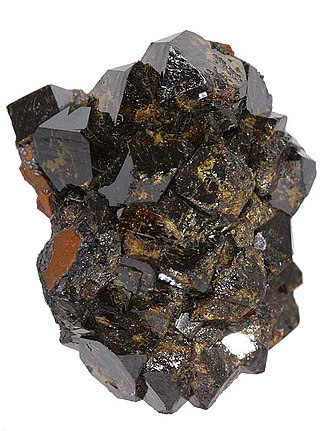
Beudandite is a secondary mineral occurring in the oxidized zones of polymetallic deposits. It is a lead, iron, arsenate, sulfate with endmember formula: PbFe3(OH)6SO4AsO4.
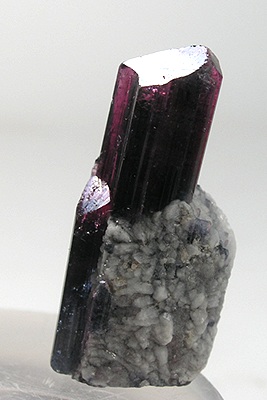
Fluor-liddicoatite is a rare member of the tourmaline group of minerals, elbaite subgroup, and the theoretical calcium endmember of the elbaite-fluor-liddicoatite series; the pure end-member has not yet been found in nature. Fluor-liddicoatite is indistinguishable from elbaite by X-ray diffraction techniques. It forms a series with elbaite and probably also with olenite. Liddiocoatite is currently a non-approved mineral name, but Aurisicchio et al. (1999) and Breaks et al. (2008) found OH-dominant species. Formulae are

Wakabayashilite is a rare arsenic, antimony sulfide mineral with formula [(As,Sb)6S9][As4S5].
Carlosruizite is a sulfate or selenate–iodate mineral with chemical formula: K6(Na,K)4Na6Mg10(SeO4)12(IO3)12·12H2O. It has a low density (specific gravity of 3.36), colorless to pale yellow, transparent mineral which crystallizes in the trigonal crystal system. It forms a series with fuenzalidaite.

Pearceite is one of the four so-called "ruby silvers", pearceite Cu(Ag,Cu)6Ag9As2S11, pyrargyrite Ag3SbS3, proustite Ag3AsS3 and miargyrite AgSbS2. It was discovered in 1896 and named after Dr Richard Pearce (1837–1927), a Cornish–American chemist and metallurgist from Denver, Colorado.
Arsenoclasite (originally arsenoklasite) is a red or dark orange brown mineral with formula Mn5(AsO4)2(OH)4. The name comes from the Greek words αρσενικόν (for arsenic) and κλάσις (for cleavage), as arsenoclasite contains arsenic and has perfect cleavage. The mineral was discovered in 1931 in Långban, Sweden.

Hidalgoite, PbAl3(AsO4)(SO4)(OH)4, is a rare member of the beudantite group and is usually classified as part of the alunite family. It was named after the place where it was first discovered, the Zimapán mining district, Hidalgo, Mexico. At Hidalgo where it was initially discovered, it was found as dense white masses in alternating dikes of quartz latite and quartz monzonite alongside other secondary minerals such as sphalerite, arsenopyrite, cerussite and trace amounts of angelsite and alamosite, it was then rediscovered at other locations such as Australia where it occurs on oxidized shear zones above greywacke shales especially on the anticline prospects of the area, and on fine grained quartz-spessartine rocks in Broken Hill, Australia. Hidalgoite specimens are usually associated with copper minerals, clay minerals, iron oxides and polymetallic sulfides in occurrence.

Segnitite is a lead iron(III) arsenate mineral. Segnitite was first found in the Broken Hill ore deposit in Broken Hill, New South Wales, Australia. In 1991, segnitite was approved as a new mineral. Segnitite has since been found worldwide near similar locality types where rocks are rich in zinc and lead especially. it was named for Australian mineralogist, gemologist and petrologist Edgar Ralph Segnit. The mineral was named after E. R. Segnit due to his contributions to Australian mineralogy.



















